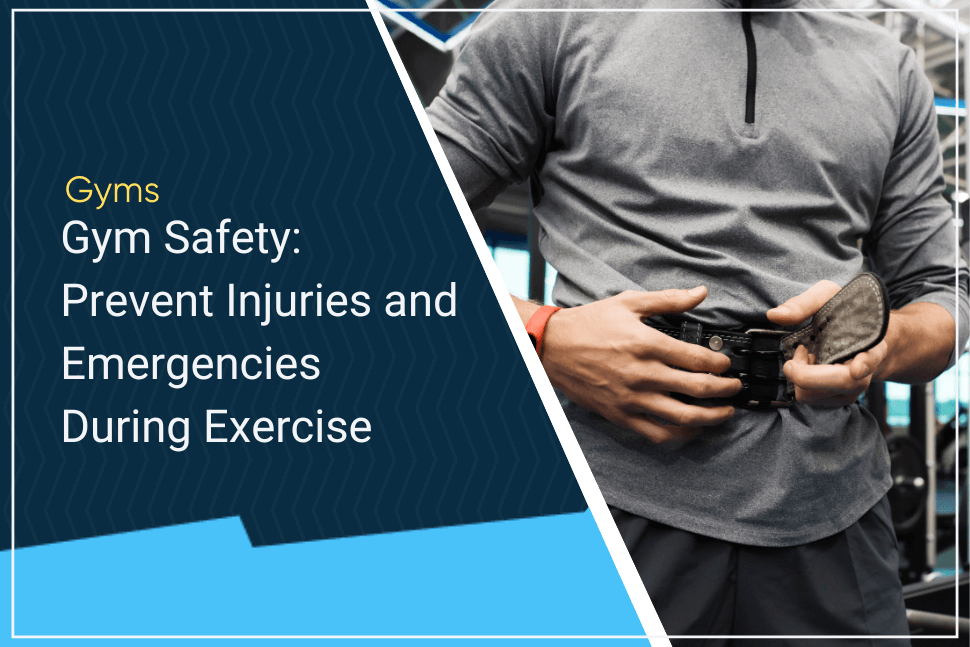Gym Safety: Best Practices to Prevent Injuries and Emergencies

Her daughter was watching, she was feeling strong, and she'd probably be the only woman to squat 400 pounds in that gym.
The strongwoman from Mexico City loaded up the smith machine, which has safety mechanisms to prevent the bar from falling too low if you can't lift the weight.
She also put a bench underneath so that she could "box squat" the massive weight. On a different machine, it would have been considered by trainers to be a safer and less demanding way to lift very heavy weight.
She unlatched the smith machine and the weight dropped.
And it crushed her neck right there in front of her screaming child.
Managing a successful gym is about more than gleaming workout machines and helping members get fit. It’s also about safety. Too often, however, gym safety tends to take a back seat as busy gyms focus on the daily grind of business.
In the cast of the tragedy above, the Mexico City woman nullified the safety mechanisms on the smith machine by placing an object, the bench, between her and the ground. If there had been no bench, her body wouldn't have been pinned between the two objects, leading to the neck break.
Neglecting safety is very costly. Beyond tragedy and injury, it leads to legal problems, and a tarnished reputation.
Here's how to do your part to prevent injuries (or worse) as a gym owner.
Prepare for a Safe Workout
Gym safety needs to be implemented during the planning and preparation stage. Here are two essentials that you should implement:
Consult a Doctor Before Starting a New Exercise Routine
Make it part of your induction process to encourage new members with unaddressed health symptoms to consult with a doctor before beginning their membership. Your proactive stance will help new members appreciate their limitations and protect them from potential injury.
We recommend putting together a medical questionnaire for new members to fill out during the induction process. Ask them about any existing medical conditions, what medications they are currently taking, past injuries, and any other conditions that may affect their workout ability.
Your induction staff should be trained to pick up on any areas of concern and recommend a doctor’s visit before the person begins their workout program. The medical questionnaire should remain part of the member’s file. It can be a valuable resource if a health issue arises.
Acquire the Proper Fitness Equipment and Gear
Gym safety starts with the purchase of equipment that is fit for purpose. Never compromise cost over quality. Go with reputable manufacturers who are known for durability and safety standards. Check for certifications and reviews from other gym owners.
Check for specific safety features such as emergency stop buttons on treadmills, safety clips on weight machines, and padded grips. All equipment purchased must be commercial grade quality and designed for many people to use every day.
Some exercise machines are fitted with safety features to help prevent accidents and injuries. Opt for these options, including treadmill emergency stop buttons and safety clips on weight machines.
Create a Safe and Healthy Environment
A safe gym requires regular maintenance and a solid cleaning protocol. Here’s how you can create an environment that prioritizes the well-being of your members:
Design a Gym Layout for Safety and Efficiency
A safe gym requires forethought in the planning stage. Here’s how you can create an environment that prioritizes the well-being of your members:
Ensure there is enough space between each piece of equipment to provide free movement. The minimum recommended distance between cardio machines is 3 feet (1 m). For strength training machines, it is 4-7 feet (1.2-2.1 m). In the free weight area, you need to provide adequate space between benches, weight racks and other equipment. There should be enough room for a spotter to assist a lifter without getting in the way of someone else.
All areas of the gym should be well lit. This is especially important on the free weight gym floor, in walkways and emergency exit areas.
You also need to have clear, visible signs throughout the gym. These should include signs for direction, signs that provide exercise guidance, safety warnings and emergency exits.
High-quality, non-slip flooring is a must-have. Rubber flooring is a good option as it absorbs impact from dropped equipment or falls.
Always put safety ahead of aesthetics when designing your gym space. Heavy equipment should be away from high traffic areas. Make sure, too, that group training spaces are not overcrowded. As a general guide, there should be 3-4 feet (1-1.2 m) between members.
Maintain a Clean and Hygienic Gym Environment
Gyms are notorious for the spread of germs and viruses, potentially leading to all manner of health problems. Yet, your business is a health club, so it is incumbent upon you to ensure that it is clean and hygienic.
Put in place a comprehensive cleaning plan for every area of the gym. Purchase cleaning products that are designed to kill germs and viruses. All detergents should be EPA-approved against pathogens responsible for cold and flu.
All staff members should receive training on proper cleaning techniques. Ensure they understand how to use cleaning products safely and effectively.
Post signs around the gym encouraging members to wipe down equipment after use. Provide a number of cleaning stations around the facility made up of disinfectant bottles and wipes.
Regularly inspect the gym to ensure that cleaning protocols are being followed and that the gym is at a high level of cleanliness.
Gym Safety Protocols and Procedures
Gym safety requires having robust procedures and protocols in place. Here are the key areas to focus on.
Regular Inspections and Maintenance of Gym Equipment
A piece of gym equipment may be used by dozens of people in a single day. The wear and tear that results may make it unsafe to use. That puts the onus on you to undertake regular inspections and proper equipment maintenance. Here’s how to stay on top of equipment upkeep:
- Maintenance Schedule: Develop a detailed maintenance schedule for each piece of equipment. This should include regular cleaning, lubrication, part replacements, and functionality tests.
- Frequent Inspections: Schedule routine inspections to check the condition of all gym equipment. Look for signs of wear and tear, loose bolts, frayed cables, and other potential hazards.
- Documentation: Keep detailed records of all inspections and maintenance activities. This documentation helps track the equipment's condition and ensures accountability.
- Prompt Repairs: Address any identified issues immediately. Tag out-of-order equipment to prevent use until repairs are completed.
Safe Use of Exercise Equipment and Machines
Take all new members through an orientation session to get them familiar with your equipment. Your instructors should demonstrate the proper safe use of machines and provide guidance on safe exercise practices. This should include advice on how much load to put on the machine to provide the appropriate amount of stress on the target muscle group.
Post clear and easy-to-understand instructions near each piece of equipment. Include visual guides and safety warnings to help users understand proper usage.
Staff members should be on the floor and proactive about helping members properly use equipment. This includes the proper form and adequate resistance loadings when using free weights like barbells and dumbbells.
Emergency Preparedness and First Aid
Being prepared for emergencies is crucial for ensuring the safety and well-being of everyone in the gym. Here’s how to enhance your emergency preparedness:
- Staff Training: Ensure that all gym staff are well-trained in CPR and First Aid. Regular training sessions and certifications should be part of their professional development.
- First Aid Kits: Place well-stocked first aid kits in accessible locations throughout the gym. Ensure they contain essential supplies like bandages, antiseptics, gloves, and emergency contact information.
- Emergency Action Plan: Develop a comprehensive emergency action plan that covers a wide range of scenarios, including medical emergencies, fire, and natural disasters. This plan should outline roles and responsibilities, communication protocols, and evacuation procedures.
- Emergency Drills: Conduct regular emergency drills to ensure that staff and members are familiar with the procedures. These drills help identify any weaknesses in the plan and ensure everyone knows how to respond in an actual emergency.
- Fire Extinguishers: Equip the facility with an adequate number of fire extinguishers, ensuring that they are regularly tested.
Promote Gym Safety Tips and Awareness
In addition to implementing safety protocols and procedures, you should actively promote safety awareness among your members. Here are two aspects that you will want to include:
Educate Members on Safety Procedures and Protocols
All members should be able to access detailed instructions on safe equipment use. This may include posters, video tutorials, and staff demonstrations.
You should also conduct regular workshops and training sessions. These should be focused on teaching proper lifting techniques and reinforcing gym etiquette.
Encourage a Culture of Safety and Responsibility
Actively encourage members to report any equipment malfunctions or safety issues to gym staff immediately. Quick action on these reports helps maintain a safe workout environment.
Promote a culture where safety and responsibility are paramount. Encourage both staff and members to be vigilant, responsible, and proactive about maintaining a safe gym space. This can be achieved through regular safety briefings, visible safety reminders, and a supportive community atmosphere.
Staff Training for Gym Safety
To create a safety culture at your gym, you need every staff member ‘s buy-in. For that to happen, each person must be trained in safety protocols. Everyone employed by your business should be able to play a hands-on role if an emergency situation arises.
When your staff is well trained in this area, they will display the confidence, knowledge and skills to minimize risks and identify potential hazards. They’ll understand equipment safety protocols, recognize signs of member distress while exercising, and confidently implement emergency procedures.
Staff who receive up-to-date safety training can better care for gym members' needs. This may include helping them safely use equipment, offering fitness advice, and answering safety-related questions.
All staff members should be familiar with legal requirements and industry standards regarding gym safety. They should know how to handle incidents, maintain hygiene standards, and comply with health and safety regulations. Staff should also trained in CPR and first aid, with annual updates.
Manage Risks and Hazards
Preventing accidents requires a proactive stance, where all staff members think safety first and manage potential risks and hazards.
Conduct Regular Risk Assessments and Safety Audits
- Evaluate Potential Hazards: Regularly assess the gym environment to identify potential hazards such as equipment malfunctions, slippery floors, or inadequate lighting.
- Assess Associated Risks: Determine the level of risk associated with identified hazards to prioritize corrective actions effectively.
- Equipment Usage: Ensure equipment is regularly inspected for safety and proper functioning. Provide maintenance schedules to address any issues promptly.
- Facility Maintenance: Keep facilities clean, well-lit, and free from obstructions to reduce the risk of accidents.
- Emergency Preparedness: Develop and maintain emergency response plans, including procedures for medical emergencies, fire drills, and evacuation routes.
Manage Crowded Spaces and Regulating Gym Capacity
- Implement Capacity Management: Implement a system to monitor and regulate the number of members in the gym at any given time to prevent overcrowding.
- Booking System or Time Slots: Consider implementing a gym booking system or time slots to manage peak hours effectively. This helps distribute gym usage throughout the day, reducing congestion and allowing for better supervision of members.
Gym Locker Room Safety and Hygiene
Locker room safety and hygiene are important aspects of maintaining an overall safe gym environment. Here are some key points to consider:
Safety
- Personal Belongings:
- Provide lockers to store personal items and ensure they are securely locked.
- Advise members not to bring valuables to the gym.
- Do not permit members to carry their gym bag onto the workout floor as this can create a tripping hazard.
- Slip and Fall Prevention:
- Keep floors dry, especially around showers and sinks.
- Use non-slip mats and rugs in wet areas.
- Advise members to wear appropriate footwear to prevent slipping.
- Emergency Preparedness Member Awareness:
- Familiarize yourself with the location of emergency exits and first aid kits.
- Report any hazards or unsafe conditions to gym staff immediately.
- Know the gym's emergency procedures and protocols.
- Personal Safety:
- Be aware of your surroundings and report any suspicious activity.
- Avoid sharing locker combinations or keys with others.
- Use the buddy system if you're concerned about personal safety.
Hygiene Advice for Members
- Shower and Bathroom Cleanliness:
- Always shower before using the pool or sauna to prevent contamination.
- Use flip-flops or shower shoes to avoid contact with fungi and bacteria.
- Clean up after yourself, ensuring showers and sinks are free from personal items and debris.
- Personal Hygiene:
- Bring your own toiletries and avoid sharing items like razors, towels, or soap.
- Wash your hands thoroughly after using the bathroom and before touching your face or personal items.
- Use deodorant and wear clean workout clothes to minimize body odor.
Locker Room Reminders for Gym Staff
- Gym staff should regularly clean and disinfect high-touch areas such as lockers, benches, and door handles.
- Report any cleanliness issues to gym management so they can be addressed promptly.
- Use provided disinfectant wipes to clean equipment before and after use.
- Dispose of trash, such as empty bottles or used paper towels, in designated bins.
- Avoid leaving personal hygiene products or food items in the locker room.
- Ensure the locker room is well-ventilated to prevent the buildup of moisture and odors.
- Report any issues with ventilation or air conditioning to gym staff.
Gym Pool Safety
Gym safety rules apply to all areas of your gym. If your facility has a pool, you have an extra level of responsibility to ensure safety in the gym and hygiene for your members. The pool should be supervised at all times with lifeguards on duty. If children are permitted to use the pool, parents or guardians should be on hand to supervise them.
Encourage members to swim with a buddy rather than going it alone. All users of the people should be well aware of the location of life rings, rescue hooks and other life saving equipment. They should also know the location of the emergency exits and first aid stations, as well as being conversant with emergency procedures.
Pool staff should enforce the pools rules, which need to be clearly posted. They should include no running, and no diving in the shallow end. Users should also respect lane assignments.
Check that all pool equipment, such as ladders, handrails, and diving boards, is in good condition.
Members and their children should have adequate swimming schools before getting onto the water. Swimming lessons may be offered to those whom are not confident swimmers.
Members should be required to shower before getting into the pool to remover dirt, sweat and body oils. They should not get into the pool if they have open wounds or infections. Additionally, they should not swallow pool water as it may contain harmful bacteria and chemicals.
Any incidents of vomiting, diarrhea or fecal contamination should be reported to gym staff straight away.
Members should not wear swim attire that can shed fibers or obstruct filters.
Chemical and Environmental Safety
Pool water should be tested and maintained regularly. Store all pool chemicals in a locked cupboard. Only authorized staff members should handle these chemicals. No one should have direct contact with pool chemicals. Any spills or leaks should be dealt with immediately.
The pool area should be well-ventilated so that harmful fumes do not build up. Pool staff should also ensure the water is kept at an appropriate temperature.
Conclusion
Safe gyms don’t happen by chance. They require careful planning, solid protocols and proactive staff members. Every part of gym management needs to prioritize safety in order to protect members and staff.
As a gym owner, it’s your responsibility to invest in high quality equipment, maintain a rigorous cleaning schedule and educate your members about safe equipment use and safety procedures.
The importance of regular equipment inspections, robust cleaning schedules, and staff training cannot be overstated. These measures not only enhance safety but also build trust and confidence among gym users. Promoting a culture of safety and responsibility encourages everyone to be vigilant and proactive, creating a supportive community atmosphere.
Now’s the time to take action. Evaluate your current safety practices and identify areas for improvement. Take the initiative today to create a safer, more welcoming gym environment.
Gym management software that frees up your time and helps you grow.
Simplified billing, enrollment, student management, and marketing features that help you grow your gym or martial arts school.





